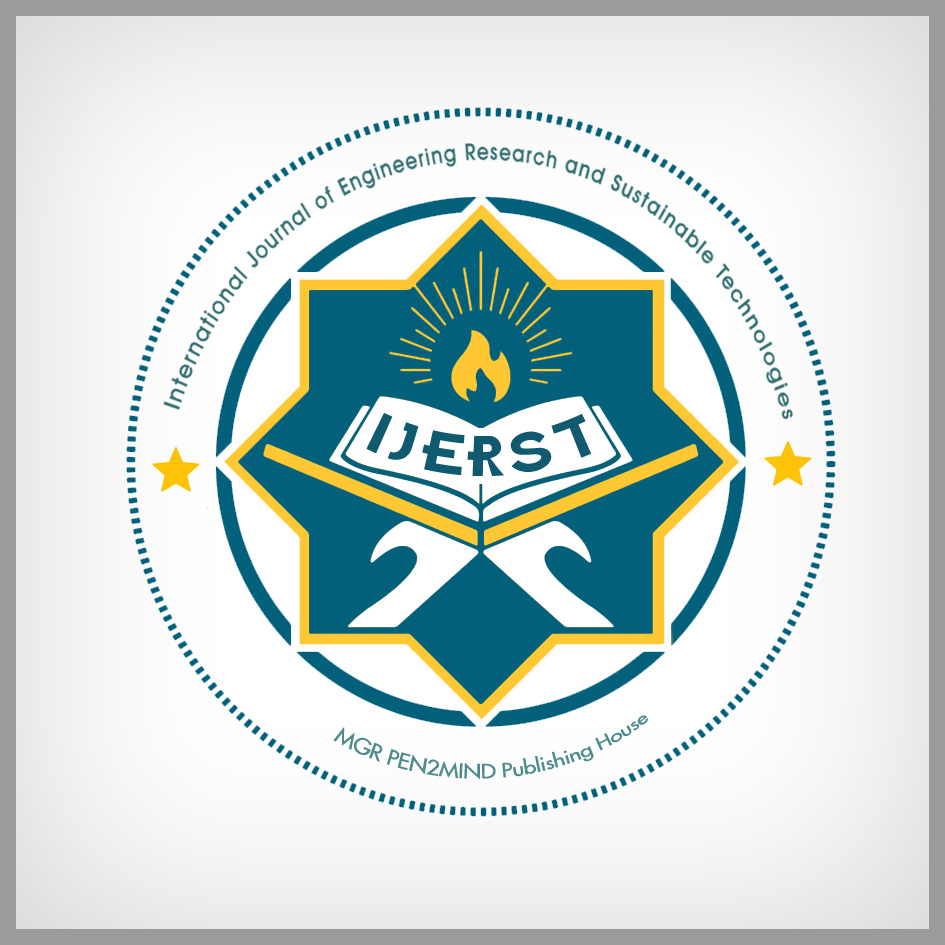ANALYSIS OF BEARING FAILURE DUE TO COOLANT OIL CONTAMINATION USING DIAGNOSTIC TECHNIQUES IN GRINDING
DOI:
https://doi.org/10.63458/ijerst.v2i1.72Keywords:
Inner and Outer ring raceway faults, diagnosis, coolant filter machines, fault detection, condition monitoringAbstract
One of the main reasons for machining breakdowns in a given industry is bearing failure. Rolling bearings are made up of bearing rings, rolling components, and cages for the rolling components' support. The term "bearing life" refers to the total amount of revolutions (or time period) a bearing can withstand before failing. Cracks, inadequate lubrication and greasing, and insufficient bearing loading on the shaft are common failure modes. The work presented here comprises several rolling bearing damage diagnosis methods and failure scenarios.Fluid contamination is considered one of the main reasons for failure in hydraulic systems. That said, there are hydraulic systems that intentionally use water as the design fluid and there is oil in water systems for various uses. The majority use specific hydraulic fluid that is less susceptible to temperature effects and provides lubrication properties. Transmission fluid can be classified as either a hydraulic fluid or a lubricant, depending on the transmission type. Moisture is a known contaminate in a wide variety of applications, but moisture in industrial oil can be particularly damaging. In addition to impacting oil performance, water degrades additives and film strength, thus presenting the opportunity for mechanical wear and corrosion. Standard equipment features such as breathers are designed to evaporate moisture from the oil. When preventative measures fail, water content in oil can reach.
References
Bhadeshia, H. Steels for Bearings. Prog. Mater. Sci. 2012, 57, 268–435. [Google Scholar] [CrossRef]
Hwang, Y.-K.; Lee, C.-M. A Review on the tightening axial force Technology of the Rolling Bearing for the Spindle of Machine Tools. Int. J. Precis. Eng. Manuf. 2010, 11, 491–498. [Google Scholar] [CrossRef]
Madar, E.; Galiki, O.; Klein, R.; Bortman, J.; Nickell, J.; Kirsch, M. A New Model for Bearing Spall Size Estimation Based on Oil Debris. Eng. Fail. Anal. 2021, 134, 106011. [Google Scholar] [CrossRef]
Kishore, K.; Mukhopadhyay, G. Root Cause Failure Analysis of Pinch Roll Bearing at Hot Strip Mill. J. Fail. Anal. Prev. 2019, 19, 219–229. [Google Scholar] [CrossRef]
Ban, J.; Liu, X.-L.; Luo, Y.; Zhao, Q. Cause Analysis and Prevention of Flaking of W9Cr4V2Mo Steel Rolling Bearing. Fail. Anal. Prev. 2015, 10, 238–242. [Google Scholar]
Tauqir, A.; Salam, I.; Haq, A.U.; Khan, A. Causes of Fatigue Failure in the Main Bearing of an Aero-Engine. Eng. Fail. Anal. 2000, 7, 127–144. [Google Scholar] [CrossRef]
Salam, I.; Tauqir, A.; Haq, A.U.; Khan, A. An Air Crash Due to Fatigue Failure of a Ball Bearing. Eng. Fail. Anal. 1998, 5, 261–269. [Google Scholar] [CrossRef]
Xu, X.-L.; Yu, Z.-W. Failure Analysis of Tapered Roller Bearing Inner Rings Used in Heavy Truck. Eng. Fail. Anal. 2020, 111, 104474. [Google Scholar] [CrossRef]
Iliev, H. Failure Analysis of Hydro-Generator Thrust Bearing. Wear 1999, 225–229, 913–917. [Google Scholar] [CrossRef]
Savaskan, T.; Veinot, D. On the Wear and Failure of High Speed Roller Bearings. Wear 1987, 116, 361–380. [Google Scholar] [CrossRef]
John, S.K.; Mishra, R.K.; Hari, K.; Ramesha, H.P.; Ram, K.K. Investigation of Bearing Failure in a Turbo Shaft Engine. J. Fail. Anal. Prev. 2020, 20, 34–39. [Google Scholar] [CrossRef]
Ejaz, N.; Salam, I.; Tauqir, A. Failure Analysis of an Aero Engine Ball Bearing. J. Fail. Anal. Prev. 2006, 6, 25–31. [Google Scholar] [CrossRef]
Mishra, R.K.; Muduli, S.K.; Srinivasan, K.; Ahmed, S.I. Failure Analysis of an Inter-Shaft Bearing of an Aero Gas Turbine Engine. J. Fail. Anal. Prev. 2015, 15, 205–210. [Google Scholar] [CrossRef]
Harris, T.A.; Barnsby, R.M.; Kotzalas, M.N. A Method to Calculate Frictional Effects in Oil-Lubricated Ball Bearings. Tribol. Trans. 2001, 44, 704–708. [Google Scholar] [CrossRef]
Averbach, B.L.; Bamberger, E.N. Analysis of Bearing Incidents in Aircraft Gas Turbine Mainshaft Bearings. Tribol. Trans. 1991, 34, 241–247. [Google Scholar] [CrossRef]
Bhat, R.R.; Nandi, V.; Manohara, V.; Suresh, S.V. Case Study on Failure of Ball Bearing of an Aeroengine. J. Fail. Anal. Prev. 2011, 11, 631–635. [Google Scholar] [CrossRef]
Murugesan, V.; Sreejith, P.S.; Sundaresan, P.B.; Ramasubramanian, V. Analysis of an Angular Contact Ball Bearing Failure and Strategies for Failure Prevention. J. Fail. Anal. Prev. 2018, 18, 471–485. [Google Scholar] [CrossRef]
Prashad, H. Diagnosis of Rolling-Element Bearings Failure by Localized Electrical Current Between Track Surfaces of Races and Rolling-Elements. J. Tribol. 2002, 124, 468–473. [Google Scholar] [CrossRef]
Dornfeld, D.; Lee, D.E. Precision Manufacturing; Springer: Berlin, Germany, 2008; pp. 1–48, 121–166. [Google Scholar]
Wang, Q.; Jiang, W.; Liu, H. Effects of manufacture and assembly errors on contact stress on the cylindrical roller bearing. Mod. Mach. 2016, 4, 32–37. [Google Scholar]
Li, T.; Kolar, P.; Li, X.-Y.; Wu, J. Research Development of Preload Technology on Angular Contact Ball Bearing of High Speed Spindle: A Review. Int. J. Precis. Eng. Manuf. 2020, 21, 1163–1185. [Google Scholar] [CrossRef]
Zou, L.; Zhou, Q.; Gao, L. Fracture failure analysis of G20Cr2Ni4A steel bearing roller. Heat Treat. Met. 2013, 38, 101–103. [Google Scholar] [CrossRef]
Mukhopadhyay, G.; Bhattacharya, S. Failure Analysis of a Cylindrical Roller Bearing from a Rolling Mill. J. Fail. Anal. Prev. 2011, 11, 337–343. [Google Scholar] [CrossRef]
Yu, Z.-Q.; Yang, Z.-G. Failure Analysis of Fatigue Fracture on the Outer Ring of a Cylindrical Roller Bearing in an Air Blower Motor. J. Fail. Anal. Prev. 2012, 12, 427–437. [Google Scholar] [CrossRef]
Halme, J.; Andersson, P. Rolling Contact Fatigue and Wear Fundamentals for Rolling Bearing Diagnostics— State of the Art. Proc. Inst. Mech. Eng. Part J J. Eng. Tribol. 2010, 224, 377–393. [Google Scholar] [CrossRef]
Cui, L.; He, Y.; Cai, C. Study on Profile Design of Cylinder Roller Bearing and Its Effect on Fatigue Life. Mach. Des. Res. 2015, 31, 67–70. [Google Scholar]
Gong, P.; Zhang, J.; Yu, Q.; Zheng, Y. Influence of Grinding Undercut on Rib Deformation for Inner Rings of Cylindrical Roller Bearings. Bearing 2s018, 4–6, 10. [Google Scholar]
Downloads
Published
How to Cite
Issue
Section
ARK
License
License Statement
This work is licensed under a Creative Commons Attribution 4.0 International License (CC BY 4.0).
Authors retain copyright of their articles and grant International Journal of Engineering Research in Science and Technology (IJERST) the right of first publication.
This license permits unrestricted use, distribution, and reproduction in any medium, provided the original author and source are credited.
The journal encourages open access and supports the global exchange of knowledge.




